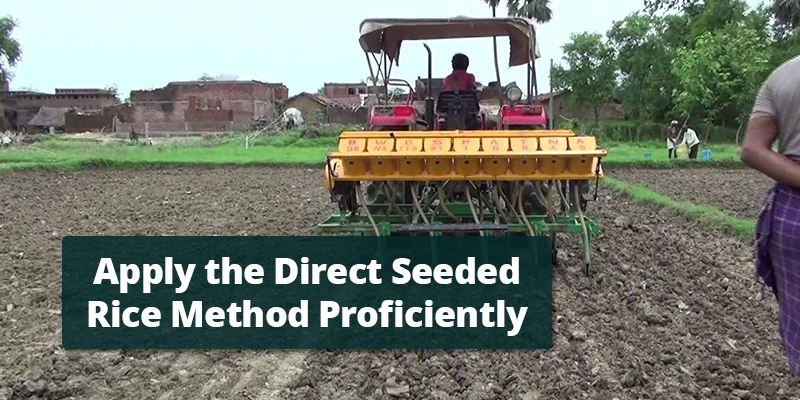Water usage is simultaneous to the cultivation of crops. One should take initiatives in which water is saved, but they should not compromise the quality of the produce. If we talk about the paddy crop, the land is badly affected after paddy transplanting, which results in damage of the upper layer of the land and this in turns affect the wheat crop.
Thus, keeping these things in mind, it is clear that direct sowing of paddy reduces the labour work of nursery and Rauni of the soil. In addition, it also helps in maintaining soil fertility, not only this, but the stability in the wheat-paddy farming system is also supported.
Rauni requires a lot of water, but when water availability is less during Rauni, it degrades the soil and harms soil fertility. Direct sowing of rice is labour intensive; it does not require any labour at the time of sowing and harvesting according to the weather conditions.
Direct sowing will prevent and save the paddy from excess use of fertilizers and poisonous chemicals. Rauni is not done in the field, due to which the soil remains porous and airy, which helps in the better spread of roots of the plant.
The direct sowing method is helpful in successfully growing paddy and winter crops. Direct sowing fields save more water than Rauni fields, as this does not create any cracks in the field. This allows the residue left on the soil surface to retain soil moisture: moderate the temperature of the soil in winters and summers, restricts weed growth, add nutrients and organic matter to the soil on decaying.
The 2 Main Methods of Direct Sowing of Paddy
1. Direct sowing of paddy with lucky seed drill
- Sowing of paddy is done from the last week of May till the second week of June; for Basmati Varieties, sowing is done from the second week of June till its last week.
- For direct sowing, shorter duration varieties of paddy like PR 126,128,129 and 1509,1121,1718 for Basmati are sown.
- The amount of seed to be used in the drill is 8–10 kg.
- Soil type – Heavy and medium clayey soils are appropriate for paddy. Loamy soil is not recommended for direct sowing.
- After the harvesting of wheat, give irrigation to the field so that the previous year’s paddy seed/weed seeds could germinate and these could not mix in the new seeds. Then plough the field, allow the field to be solarised under the sun. After this, level the field with the laser leveller and apply irrigation to the field. Then, use the rotavator in the wet field and plough the field again so that moisture in the field could get appropriately ploughed. Immediately after that, start sowing with the drill by keeping a proper row to row gap. Start sowing from the sides of the field towards the tubewell.
- In the 200-litre tank of the lucky seed drill, two medicines are used that are stomp @ 1 litre, and sathi @ 100 gram per acre.
- For seed treatment, the seeds are to be immersed in carbendazim streptocycline water for 8–10 hours before sowing the seeds and afterwards allow them to dry in the shade.
- Paddy will start germinating on the seventh day, but the first irrigation is to be done after 18–21 days according to the weather conditions.
- Manure must be applied @ 130 kg in four instalments, no DAP is required, and zinc or other nutrients must be added if needed as per soil report.
2. Direct sowing of paddy with DSR drill
The method of direct sowing with the DSR drill is similar to that of the method discussed above, the only difference is that in this process, you have to spray the medicine separately. You must note that you should not walk on the sprayed medicine barefoot.
Benefits of Direct Sowing:
- With this method the crop gets ready earlier, which also helps in the early sowing of next crops. By direct sowing, the crop gets prepared in about 10–15 days in advance.
- It saves 35–40 %of water, reduces the input cost by Rs 3000 per hectare and increases the yield by 10%.
- It saves energy, seeds, fuel and effort of labour.
Problems and its Solutions
Any deficiency in the crop can be resolved by spraying the crop with a particular chemical. Besides the chemical use, there are ample organic methods for the control of soil fungus, crop fungus, sap-sucking insects or for the growth promotion. Trichoderma culture, pseudo, alum, asafoetida, neem, jaggery, nectar, black salt can be used instead of Surplus fungicides, insecticidal poisons and expensive growth promoters. It will reduce the input cost.
Conclusion
In conclusion, I would say that anyone who understood the system of direct sowing and has learnt the management of weeds would find it as a simple and low-cost method as sowing wheat. Also, there will be no need of stubble burning after making hay. It is our moral responsibility to save water and resources.
However, many farmers have not adopted the paddy direct sowing method due to doubts, lack of information or old assumptions. If you have any queries related to direct sowing of paddy or regarding any other crop, then visit Apni Kheti website or download the app. Through Apni Kheti application, you will get answers to your queries from experienced and educated agriculture experts who will lead you to the right track of farming.
For more information about Agriculture and Livestock, download Apni Kheti app – Android, iPhone





